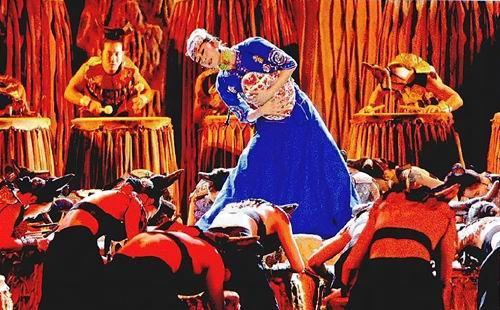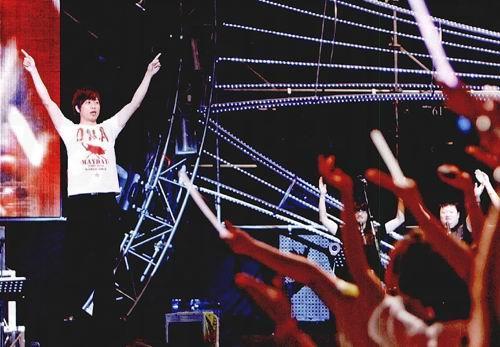Thriving Performing Arts Market in China
2009-10-30ZHANGXUEYING
ZHANG XUEYING
The Sound of Yunnan is her third dance drama. Over 40 major companies showed their
interest in being a part of it – even before it was completed.
WE need more laughter to survive the depressing economic situation,” says Wang Ying, marketing director of a creative culture company. “You see comedy has now become the most popular film genre in the cinema. Even drama, which used to be unpopular in places like Shenzhen, now wins great acclaim and even finds success at the box office.” Wang Ying goes on to say, “People in difficult situations desire the arts, performances that will bring them joy and help them to forget their cares and woes.”

Wang Ying noticed that since the last half of 2008, tickets for the drama performances she planned all quickly sold out. “We no longer worry about facing a deficit.”
Not only in Shenzhen, but across the whole country the performing arts market seems to be thriving. When famous Hong Kong singer Andy Lau held concerts in Shenyang and Changsha last March,ticket sales went far beyond the organizers expectations. The Jackie Chan and Friends Concert held last May in the Birds Nest stadium in Beijing attracted an audience of over 50,000 people, easily recouping the costs of the show just on box office receipts alone. In July, the renowned dancer Yang Liping made an impressive box office showing with her latest performance The Sound of Yunnan. The tickets were sold out a week before the show opened.
Top-notch Performance
Ensures Box Office
Yang Liping still believes that only a good performance can ensure box office. She spent a year in Yunnan Province to find inspiration in the landscape to prepareher work The Impression of Yunnan. She also visited Tibetan areas several times to choreograph Tibetan Mystery. Yang Liping evaluates herself as “having a taste for art with the courage to innovate.” Her rich experience as a dancer has helped make her sensitive to the desires of the audience and the needs of the organizers. She always tries to view her work through the publics eyes. “Any details that do not maintain the atmosphere I wish to create must be improved and any part that is less than inspirational should be abandoned,” Yang Liping believes.

Yang considers dancing as her life and cannot bear to have any imperfections in her work. Though The Impression of Yunnan has already been performed for over five years, she continues to polish and improve it like an organic piece of art. The Sound of Yunnan is her third dance drama. Over 40 major companies showed their interest in being a part of it – even before it was completed.
The National Center for the Performing Arts is another shining example of the thriving performing arts market. The Opera Festival that took place from April to July continually played to 88 percent-full houses. Deng Yijiang, spokesman for the National Center for the Performing Arts, says frankly: “Opera is an adopted art that still has an aesthetic distance to reach the general public, so we didnt expect too much from the box office.” Music reviewer Liu Xuefeng thinks the unexpected success is due to the famous players and opera troupes. “The first-class performances represent the developing trend in opera.” Leo Nucci, the worlds greatest Verdi baritone, was invited to play Rigoletto during the opera festival. He found himself deeply moved by the Chinese audiences passion and got down on his knees for the curtain call. The master decided to perform again in China in 2010. Audiences were also treated to the modern opera brought by the Teatro La Fenice (The Phoenix) from Italy. They performed the classic opera Madame Butterfly in an avant-garde style.

Art on a Budget
According to Deng Yijiang, the low-priced tickets are one of the strategies to win over the market. Tickets under RMB 100 still sell best across every type of performance. Most regular people feel comfortable buying tickets at the price of around RMB 80 to enjoy a performance in the new National Center for the Performing Arts.
The financial crisis that swept over the world in recent years has deeply influenced the global performing arts market. Performance groups throughout Europe and America have had to cancel some tours to reduce expenses. “It is good news for China,” Lin Hongming, general manager of the Shanghai Oriental Art Center,points out. “The downturn allows for a more refined selection of acts, maybe higher level. On the other hand, the acts are willing to play for less, due to our cuts in ticket prices, and reductions in the number of performances, but the overall understanding is that the quality will be maintained.”
The average ticket prices for foreign acts performing in Chinas mainland tend to surpass those in Hong Kong, London, New York and Tokyo. The tickets for Sarah Brightmans last concert were priced between RMB 800 and 1,000 in Japan. Though the same tickets in Beijing were priced between RMB 380 and 2,000, with the amount of the low-priced tickets being far less than the high-priced, the average price was nearly RMB 1,000. As the per capita income is lower in China (RMB 13,786 in 2008, according to data from the National Bureau of Statistics) than in developed countries like Japan, U.S. and Britain, that adds up to an even bigger gap in the ticket value.

In 2005, the performance of the Berlin Philharmonic Orchestra organized by Lin Hongming was so warmly welcomed by Chinese audiences that the ticket prices had skyrocketed to over RMB 4,000. In 2008, the Berlin Philharmonic Orchestra and the Oriental Art Center negotiated a performance in China for 2011. But this time Lin Hongming drove a hard bargain: “We can offer only half of the performing fee of three years ago. If they agree to charge less, we will talk about further cooperation.” Lin hopes the orchestra will lower its price under the current circumstances. This is not only aimed at keeping the costs down, but also at lowering the ticket prices and, making the performances more accessible to the average person.
The negotiations between the Shanghai Grand Theater and the Chicago Symphony Orchestra achieved a breakthrough – the organizer cut the players charges down by 50 percent of that in 2007. “The reduction in artist fees allow us to offer more low-priced tickets,” says Qian Shijin, art director of the Shanghai Grand Theater. According to Qian, in the past high ticket prices were driven up by a disordered domestic competition that left foreign orchestras feeling that Chinas huge market would be willing to pay whatever they asked for.” Lin Hongming considers the financial crisis an opportunity since “it can drive out incompetent smaller firms, leaving the bigger companies to hold negotiations in a more steady and orderly market environment.”
Cultivating the Market
It was a common understanding among performance agencies that Shenzhen people had no fancy for dramas. A few years ago, the well-received Beijing Peoples Art Theater performed its forte Teahouse in Shenzhen, but it closed on a down note – less than a third of the seats were filled for the performances in a 1,500-person-capacity theater.
These days people in Shenzhen have come around and learned to enjoy drama. The Royal Tramp that played this past May earned over RMB 100,000 in box office receipts within its first three days. Tickets at the lower prices of RMB 80 and 180 were almost all sold out. “The market needs to become acclimated just like when cultivating a new hobby,” says Wang Ying.
Many people share the same opinion with Wang Ying. “What we hope to do is to help more young people understand and enjoy the charms of opera. Because a cause without young peoples participation is hopeless,” Deng Yijiang emphasized.
Since the end of last year, the National Theater for the Performing Arts has launched an “opera lecture program” to cultivate potential audiences. By marketing at banks, airline companies, universities, cultural centers and residential communities, they draw attention to the beauty of opera and develop public appreciation for it. Over 300,000 people have participated in this program and numerous netziens continue to follow it closely via the Internet. “This activity promotes opera systematically, teaching audiences to understand this art, helping them to see opera parallels in everyday life,” said Hao Weiya, assistant professor from the Central Conservatory of Music, and one of the programs lecturers.
During the opera festival that lasted from April to July of this year, the National Theater for the Performing Arts held a “classical art lecture” and an “opera-lovers salon,” which invited experts and artists to analyze various aspects of classic works and share their fascinating perceptions of each performance. Moreover, everyday there were six to nine hours worth of performances of classical opera fragments in the theaters public performance space, which attracted over 200,000 people and introduced them to general opera facts, plots and roles.
The Nessun Dorma – an opera themed exhibition in the theater – also helped to attract large numbers of visitors. The displayed manuscripts, costumes and props, and even a video of opera master Giacomo Puccinis one and only filmed performance help provide other direct ways for the public to understand the art and promote their enjoyment for generations to come.
“What we hope to do is to help more young people understand and enjoy the charms of opera. Because a cause without young peoples participation is hopeless.”
